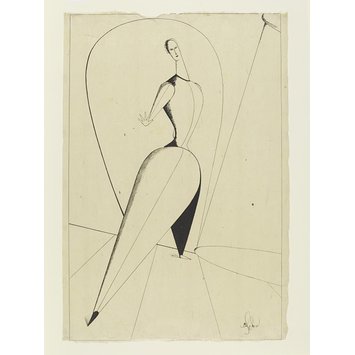It cost five German Marks for the holder of this ticket to attend Bauhausfest on 4 December 1926, an event attended by more than 1,000 guests to inaugurate the school’s new buildings in Dessau. Severe budget cuts and the cancellation of Masters’ contracts by the incoming right wing party Thüringer Ordnungsbunde in March 1925 had forced the move from Weimar. The choice of industrial Dessau, with its machine assembly plants and aircraft factories, supported founder Walter Gropius’ 1923 slogan, ‘Art and technology – a new unity’, signalling a re-focus on the design of aesthetically modern products suitable for mass production.

The town’s council funded the construction and subsequently commissioned Gropius to design Dessau-Törten, an estate of 314 affordable homes. The arrival of this famous group of artists greatly enhanced Dessau’s reputation as an industrial centre, however, awarding such an important architectural contract to the school inevitably created tensions.
The parties and festivals that were an important part of Bauhaus culture were written into its governing principles. Not only aimed at fostering a community spirit between the school and local community, as well as diffusing any tensions between students and staff, they were another teaching tool, providing students with opportunities to produce designs based on their understanding of the theories of material properties, colour theory and composition. The inclusion of a small framed stage in the main hall emphasised their pivotal role.
Gropius’ birthday in May, the Lantern Party at the Summer Solstice, and the Kite Party in autumn, were just some of the regular fixtures and themed costume parties, birthdays and Christmas were also enthusiastically celebrated. Oskar Schlemmer, Master of the theatre workshop was a key protagonist who used these events to develop his experimental explorations of modernity, first seen in his famous production, Triadic Ballet (1922). Preparations went on for days and invitations, interior decoration, costumes, performances, props and music were designed with industrious attention to detail, with an emphasis on ‘play’.
Costume and ambiance were critical. The invitation to the legendary Das weisse Fest (The White Party) on 20 March 1926 requested that guests dress, ‘⅔ in white, 1/3 in colour and the remaining in squares, spots or stripes.’ As Schlemmer observed about the Bart, Nasen und Herzens fest (Beard, Nose and Heart Party) in 1928: ‘Even Kandinsky had put on a red Sudermann beard, Klee side-whiskers, Hannes Meyer a big nose.’ At the Metallisches Fest (The Metal Party) in February 1929, guests entered the party along a long metal slide. Symbolising the technological age, shiny spheres of silver metal and glass dangled from the ceiling, the building’s windows were covered in tinfoil and the staircase was transformed into a musical instrument with each step activating a bell, reflecting the ‘glocken schellen lingel fest’ (bells ring the bell party) sub-text of the invitation. The house band, die Bauhaus-Kapelle, created the party atmosphere, playing traditional and improvised instruments that were occasionally destroyed as part of the performance.

The ‘buhnenspiele’ (stage play) flyer design for the Bauhausfest on 4 December is influenced by Constructivism and the sans serif characteristic of the New Typography. It also illustrates the decision of the school to use only lower case lettering. Performances included Schlemmer’s Bauhaus Dances such as ‘gestentanz’ (gesure dance) and ‘formentanz ’ (shape dance). These were Constructivist influenced explorations of geometric forms or props on the human body where performers wore exaggerated padded costumes and masks evoking dolls and puppets, and used props such as poles and hoops. One of Schlemmer’s sketches in the V&A collection illustrates well the silhouette the performers aimed to reproduce.

The buildings at Dessau housed the school until 1930 and are now regarded as icons of Modernist twentieth century architecture and designated Unesco world heritage sites. The extraordinary events that took place inside them synthesising imagination, art and technology have influenced performance theory, contemporary dance and immersive themed experiences ever since.


